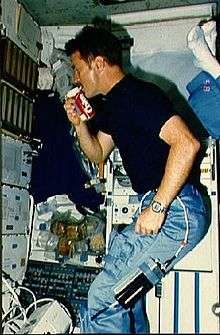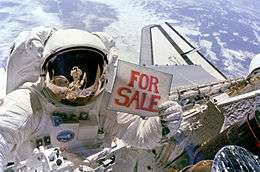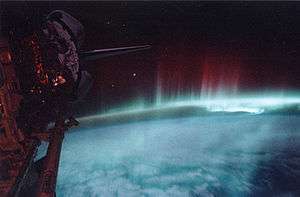Space advertising
Space advertising is the use of advertising in outer space or related to space flight. While there have only been a few examples of successful marketing campaigns, there have been several proposals to advertise in space, some even planning to launch giant billboards visible from the Earth. Obtrusive space advertising is the term used for such ventures.

Advertising in space has faced criticisms for contributing to the existing problem of space debris and "polluting" the view of space as seen from the ground. It is regulated by several international and national legislation, though as technology improves further regulation will likely be required to cover new forms of space advertising. While space advertising is limited by both contemporary regulation and technological capability, in popular culture, space advertising has taken a variety of forms and displays.
History
Beginning in the 1990s, when space technology became more available for companies after the Space Race and the fall of the Soviet Union,[1] space advertising became a point of interest for various organizations to use as a marketing tool. There have been numerous attempts at space advertising since then, including Elon Musk’s SpaceX launching of a Tesla car into orbit.[2][3]
A major advantage of space advertising over other Earth-bound methods is the sheer scale of reach. Millions of people across multiple countries can be exposed to an advert orbiting Earth. As such, space advertising can provide valuable advertising capabilities, though relatively high start-up costs have prohibited this from becoming a commonplace advert media.[4][5] When considering the fact that companies are willing to spend millions for short Super Bowl commercials, the sheer benefits provided by space advertising are very enticing for companies for advertising purposes.[6]
Attempts
The high cost of orbital spaceflight (millions per launch) has discouraged attempts in the past.[7] Space exploration authorities have also been reluctant to cater to advertisers. For example, NASA's restrictive policy on its employees' endorsing of products required astronauts to refer to M&M's as "candy-coated" chocolates (although the current administrator of NASA, Jim Bridenstine, argues for revising this policy).[8][9]
Successful attempts
.jpg)
The number of successful projects is low, due to the high cost of orbital launch and of maintaining the advertisement over time.[10] Considering that SpaceX's minimum cost for sending objects into space is already in the millions, there have not been many attempts, and fewer successful attempts. Out of the few successful attempts that have worked, even fewer companies have managed to gain the publicity that they desire; Elon Musk is one such exception in sending out his Tesla Roadster into space.[2][11]
Some of the successful attempts include, but are not limited to, the following list:
- Tokyo Broadcasting System (1990) - Paid spaceflight where a journalist was sent into orbit with the company logo on space vehicle[12]
- Pepsi (1996) - Paid approximately US$5 million to have a cosmonaut float a replica of the company's soda can outside the Russian space station[12]
- Tnuva (1997) - Filming of a milk commercial in space for the Israeli company[12]
- Pizza Hut (2000) - Paid approximately US$1 million for a space ad that saw their logo painted on a rocket[12]
- Element 21 (2006) - Russian cosmonaut Mikhail Tyurin hit a golf ball from the ISS porch as part of a commercial with Element 21[13]
- SpaceX (2018) - Sent a Tesla Roadster into orbit as the dummy payload for Falcon Heavy test flight[14]
- Rocket Lab (2019) - Sent a shiny object, the Humanity Star, into orbit[15]
Failed attempts
Although the sheer number of attempts of space advertising is not significant, there have been several past failed attempts as companies and organizations around the world planned different projects and plans to launch some type of marketing ploy into space.
Some of the failed attempts that have occurred in the past include, but are not limited to, the following list:
- France (1987) - Project named "The Ring of Light" which involved the launch of an inflatable ring in space[16]
- Russian Space Program (1990s) - Russian space program that involved the launch of satellites designed to reflect and beam sunlight to polar regions on Earth[12]
- Space Marketing Inc. (1993) - Proposed launching a giant billboard into space[6]
- China (2018) - Proposed putting an artificial moon in space[17]
UN Treaties and Government Acts
While space advertising is a relatively new concept, it is subject to a some international treaties and national policies either specifically on space advertising or space commercial activities.
UN treaties
- Outer Space Treaty (1966) sets principles of international space law. It determines that all States should have the right to freely explore the outer space.[18] This treaty provides free access to space so space advertising is not subject to global prohibition.[19]
- Space Liability Convention (1972) rules that a State is fully liable for damages caused by space objects launched in its territory. Under this treaty, States are responsible for private launches for commercial purposes, including advertising.[20]
Government acts
- 51 U.S. Code 50911 regulates that no license will be issued and no launch will be permitted for activities that involve obtrusive space advertising. This prohibition does not apply to other forms of advertising, such as displaying logos.[21] The display of logos is allowed in both launches with commercial licenses and launches with experiment permits.[22]
- US's National Aeronautics and Space Administration (NASA) is discussing on loosening its commercial restriction policy as a governmental agency.[23] It is considering to sell the naming rights of its spacecraft for financial purposes.[23] Loosening such restrictions might cause more brands to conduct space advertising.[24]
- In 2019, NASA opened International Space Station (ISS) for space advertising and other short-duration commercial activities conducted by private companies' crews.[25]
- In November 2016, Japan legislated a licensing system for private-sector companies' launching. This act aims to stimulate Japanese's commercial activities in space by supporting third-party liability insurance as well as channeling more liability onto launching companies to assure customers who pay the launchers.[26]
- Russia prohibits launches which contaminate the outer space and create unfavorable environmental changes.[27] However, there is no explicit ban on space advertising despite the light pollution and debris it potentially creates.[28][29]
Criticism
Obstacles
There is also growing concern about the dangers that can be caused by launching more objects - including advertisements - in space. Placing more satellites in space could increase opportunities for collisions, as stated by John Crassidis, a professor of mechanical and aerospace engineering at the University at Buffalo. He believes that the biggest issue will be how the additional satellites can potentially become space debris.[30] An implication of the additional advertising satellites in space could contribute to the Kessler syndrome. Many other incidents of space collisions have occurred:
- French satellite collision (1996) - First verified case of collision between artificial space objects that further contributed to space debris.
- China's anti-satellite test (2007) - Contributed to more than 3,000 pieces of space debris.
- Russian satellite (2009) - A Russian satellite that was no longer functioning collided with a functioning U.S. Iridium commercial satellite and contributed to more than 2,000 additional space debris.[31]
Pollution
Aside from the danger that can be brought about with increasing space advertising, pollution is also another problem. A paper that was presented to the United Nations by International Astronomical Union stated that "Scattered light from sunlit spacecraft and space debris, and radio noise from communications satellites and global positioning systems in space, reach the entire surface of the Earth”.[32] Furthermore, there is currently no international consensus on the best way to remove the space debris since space in the international territory and so the increase in space debris will also make space even more impenetrable because of the increased likelihood of collision which can deter future space missions.[33]
In popular culture
Advertising in outer space or space flight has been featured in several science fiction books, films, video games, and television series, most frequently in the animated series Futurama. They are usually shown as a satire of commercialization.
Film
- In the 2008 computer-animated science fiction film WALL-E, the star liner spacecraft Axiom features a wide variety of advertisements for Buy n Large products.
- In the movie Hancock, the logo of the fictitious All-Heart charity is painted on the Moon by the title character.
 Logo used by the Planet Express company in Futurama
Logo used by the Planet Express company in Futurama
Literature
- In Fredric Brown's 1945 short story, "Pi in the Sky," an inventor rearranges the apparent positions of the stars to form an advertising slogan.[34]
- In Robert A. Heinlein's 1951 novella The Man Who Sold the Moon the protagonist raises funds for his lunar ambitions by publicly describing means of covering the visible lunar face in advertising and propaganda, and then taking money not to do so.
- In Isaac Asimov's 1958 short story "Buy Jupiter", a group of extraterrestrials broker a deal with the governments of Earth to purchase the planet Jupiter for use as an advertisement platform to passing starships from their worlds.
- In Franquin's 1961 comics album Z comme Zorglub, Zorglub tries to write an advertisement for Coca-Cola on the Moon.
- A Red Dwarf novel features an advertising campaign whereby a ship is sent on a mission by The Coca-Cola Company to cause 128 stars to go supernova in order to visibly spell the words "Coke Adds Life!" across the sky on Earth. The message is intended to last five weeks, and be visible even in daylight.
References
- "The Space Race". HISTORY. Retrieved 2019-10-30.
- Alexander, Harriet; Horton, Helena (2018-02-06). "Elon Musk sends Tesla car to Mars on SpaceX rocket". The Telegraph. ISSN 0307-1235. Retrieved 2019-10-30.
- tech, Holly Brockwell 2019-03-30T12:00:20Z Future. "The great ad-space race: the history of space advertising". TechRadar. Retrieved 2019-10-30.
- "A Brief History of Space Advertising". The 8 Percent. 2016-04-11. Retrieved 2019-10-30.
- "How much does space travel cost?". NBC News. Retrieved 2019-11-06.
- "A Company Once Tried to Put a Kilometer-Wide Billboard in Space". Curiosity.com. Retrieved 2019-10-30.
- Chaikin, Andrew. "Is SpaceX Changing the Rocket Equation?". Air & Space Magazine. Retrieved 2019-11-06.
- Grush, Loren (2018-09-11). "Product placement may help power NASA's next big space mission". The Verge. Retrieved 2019-11-08.
- "Logos in Space: The Future of Advertising?". LogoGrab Blog. 2018-09-24. Retrieved 2019-11-08.
- By (2019-05-08). "This Space For Rent: Advertisements In Orbit". Hackaday. Retrieved 2019-10-30.
- "How much does space travel cost?". NBC News. Retrieved 2019-10-30.
- "Advertising in Space - Spaceflight & Aerospace Industry Marketing". Martin Wilson. 2016-10-25. Retrieved 2019-11-06.
- "Cosmonaut shanks longest golf shot in history". www.newscientist.com. Retrieved 2019-11-08.
- Wilkin, Nathaniel Lee, Rebecca. "Elon Musk sent a $100K Tesla Roadster to space a year ago. It has now traveled farther than any other car in history". Business Insider. Retrieved 2019-11-06.
- "Space Billboards Are Just the Latest Orbital Stunt". Wired. ISSN 1059-1028. Retrieved 2019-11-06.
- LEWIS, PETER. "France's ring of light | Maclean's | JANUARY 5, 1987". Maclean's | The Complete Archive. Retrieved 2019-11-06.
- "Could China really launch a 'fake moon'?". 2018-10-20. Retrieved 2019-11-04.
- "The Outer Space Treaty". www.unoosa.org. Retrieved 2019-10-30.
- "Space Billboards Are Just the Latest Orbital Stunt". Wired. ISSN 1059-1028. Retrieved 2019-11-05.
- Dempsey, Paul. "National Legislation Governing Commercial Space Activities" (PDF). United Nations Office for Outer Space Affairs. Retrieved 2019-11-05.
- Lodge, Emma (2016-12-04). "51 USC § 50911 – Space Advertising". foundations of law and society. Retrieved 2019-10-30.
- "Commercial Space Advertising". Ground Based Space Matters. 2018-09-12. Retrieved 2019-11-01.
- Davenport, Christian (2018-09-10). "Why NASA's next rockets might say Budweiser on the side". Washington Post. Retrieved 2019-11-01.
- "Logos in Space: The Future of Advertising?". LogoGrab Blog. 2018-09-24. Retrieved 2019-11-05.
- Spaceflight, Hanneke Weitering 2019-06-07T15:03:33Z. "NASA: The International Space Station Is Open for Commercial Business in Orbit". Space.com. Retrieved 2019-11-06.
- "New Law Aims to Expand Japan's Space Business". nippon.com. 2017-03-03. Retrieved 2019-10-30.
- "National Space Law Collection: Russian Federation". www.unoosa.org. Retrieved 2019-10-30.
- "This Russian startup wants to put huge ads in space. Not everyone is on board with the idea". NBC News. Retrieved 2019-11-05.
- Rayne, Elizabeth (2019-01-20). "Russia wants to put billboards in space. Astronomers don't like it". SYFY WIRE. Retrieved 2019-11-05.
- "This Russian startup wants to put huge ads in space. Not everyone is on board with the idea". NBC News. Retrieved 2019-11-08.
- Garcia, Mark (2015-04-13). "Space Debris and Human Spacecraft". NASA. Retrieved 2019-11-08.
- "Space Billboards Are Just the Latest Orbital Stunt". Wired. ISSN 1059-1028. Retrieved 2019-10-30.
- Davey, Melissa (2017-03-25). "'We've left junk everywhere': why space pollution could be humanity's next big problem". The Guardian. ISSN 0261-3077. Retrieved 2019-11-08.
- Yurchak, Yevhen Kukhar, Irina. "You books. Fredric Brown. Pi in the Sky". You-books.com. The biggest library. Retrieved 2019-11-08.
External links
| Wikimedia Commons has media related to space advertising. |

